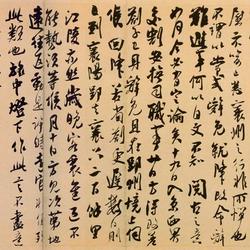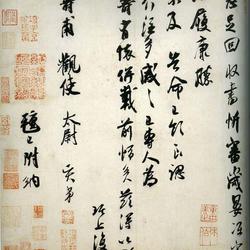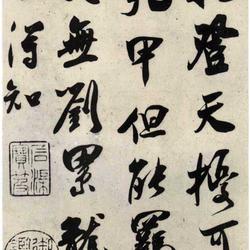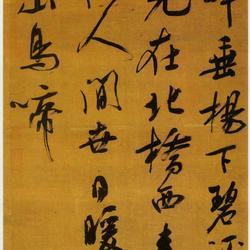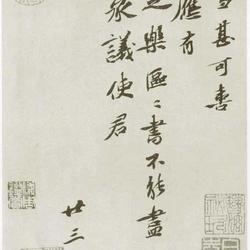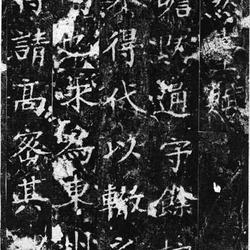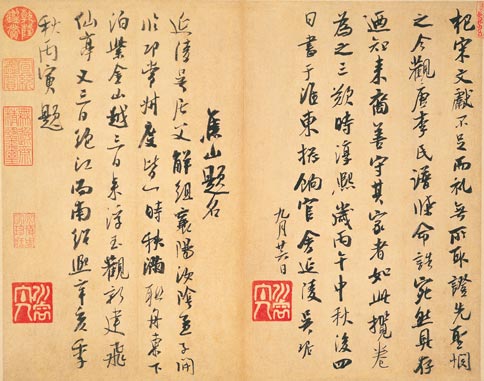
Wu Ju's "Knowing the Language and Inscribing Names on Jiao Mountain" running script 32.8 x 44.9 cm
Collection of the National Palace Museum, Taipei
Explanation: There are insufficient documents in Qi and Song Dynasties. But there is no evidence for the ceremony. The First Saint has mercy on him. Now look at the genealogy of the Li family in the Tang Dynasty. Just like it exists. I know that this is the case for those who are good at guarding their homes. I sighed three times when I took the scroll. At that time, Chunxi was four days after the Mid-Autumn Festival at Bingwu. The book was written in the official residence of Huaidong. Yanling Wu Ju. September 26th.
Jiaoshan title. Wu Ju's father was in Yanling. Disorganize Xiangyang. Ruyin Mencius opened Linqiong to visit Chang Shu. All at once full rank. Lian Zhou went eastward. Parked in Purple Mountain. Over three days. Come to Fuyu Temple to build the new Feixian Pavilion. Three more days. Across the river and south. Titled by Bingyin in the Qiu period of Xinhai and Shaoxi periods.
This piece of Wu Ju's "Book of Inscriptions and Jiaoshan's Inscription" is a combination of two "Guan Li Family Genealogy" and "Jiaoshan's Inscription". The two posts are not related in content, and the time they were written is also different. The former is a postscript written by Wu Ju in the thirteenth year of Chunxi (1186) when he reviewed the Li family genealogy of the Tang Dynasty and lamented that the genealogy should be taken seriously. The latter copied the words he inscribed in Jiaoshan on his way to Xiangyang in the second year of Shaoxi (1191). Jiaoshan is located in Zhenjiang, an island hill on the Yangtze River. Due to its beautiful scenery, many literati and calligraphers have left precious ink marks here.
He was good at poetry and calligraphy, and was often appreciated and called upon by Xiaozong of the Southern Song Dynasty. Wu Ju's calligraphy, in addition to often copying the calligraphy of Zhong Yao and Wang Xizhi, also imitated Mi Fu, even to the point of resemblance in form and spirit.
Although the calligraphy in this piece of writing is all in small cursive script, the strokes are full of movement and rhythm, and the ink color changes richly. The structure of the characters is also not square, and often has a slanted posture. The characters are tilted and postured, which is the characteristic of steep places. Although the writing style of the whole article is more subtle than Mi Fu's calligraphy style, it is full of freedom and unrestrained spirit.
other information:
Wu Ju (active in the late 12th century AD), named Jufu and named Yunhe, was a native of Kaifeng (now Kaifeng, Henan). His birth and death dates are unknown. Son of Wu Yi (1124-1171), nephew of Empress Wu, Emperor Gaozong of the Song Dynasty. When Chen Fuliang (1137-1203) was in Taixue, he held discipleship rites, cherished his reputation and feared discussion, and did not pride himself on being a relative of the royal family. He was highly appreciated by Xiaozong (reigned 1163-1188) and was often called upon to discuss poetry and write calligraphy. In the ninth year of Qiandao (1173), he was specially awarded the title of general magistrate of Lin'an Prefecture, Li Shangshulang. During the Qingyuan period (1195-1200), he was the envoy of Anjun in Guanzhen. Later, in addition to Mingzhou and coastal envoys, Ning Zongchu In the 1980s, I learned about Ezhou, and then I learned about Qingyuan Mansion. In the second year of Jiatai (1202), he was ranked as the least master and was given the posthumous title Zhonghui. This document is all signed with a year mark, which can provide two pieces of dating information about his life. He was "in charge of calculating the total military pay" in Huaidong, in Bingwu (1186), the thirteenth year of Chunxi, Emperor Xiaozong. In the second year of Xinhai (1191) of Shaoxi, Xiangyang Shiguangzong was dismantled. When Xiaozong passed away, Guangzong (reigned 1188-1194) was unable to mourn due to illness, so he and Zhao Ruyu decided to establish Ningzong. He was also good at diplomacy and sent an envoy to the Kingdom of Jin. The Jin people praised his integrity and said, "Wu Ju is the only envoy to Nanzhong who can be trusted." (Note 1) The existing works range from the last years of Chunxi (1174-1198) to Shaoxi (1190). -1194) Mainly in the early years. The two running scripts before and after this piece also belong to this period.
Wu Ju's calligraphy was founded by Zhong Yao (153-230) and Wang Xizhi (307-365), and later commentators said that his calligraphy was incomparable to Mi Fu (1051-1107). Judging from the surviving calligraphy, it is indeed like Mi Fu, regardless of the origin, and even mistakenly thought that it was written by Mi Fu. Dong Qichang (1555-1636) said: "Wu Ju's calligraphy can't be seen outside the Minang Palace. There is the best Jiangshan Xuan calligraphy in the world on Beigu Mountain in Jingkou, which is his pen. I saw a seven-character rhymed poem under the capital, without a name. But there is a layman's seal of Yunhe, and I occasionally read the classics and records. Yunhe collected it and Wu Ju wrote it, and I know it is Jushu." (Note 2) Zhang Chou (1577-1643) also said: "In this world, there are books written by the Ministry of Rites using Yunhe. The seals are all written by Wu, and connoisseurs must not know about them." (Note 3) The "Seven Character Quatrains" written by Wu Ju in the collection of this case does not have the seal of "Yunhe Jushi", so it is dated to Wu Ju, and it is the only one of the Song Dynasty in existence. Book scroll.
During the Zhenghe period of the Northern Song Dynasty, Wang Yanfu (year of birth and death unknown) wrote the "Surname Article" in "Shi Shi", which lamented that "the genealogy has not been revised for a long time, and the Jin Dynasty's eastward journey to the Central Plains was chaotic, and the clothes and clothes were scattered." (Note 4) Therefore, an article from "Shi Yu" means "Three Sighs". "Inscription on Jiaoshan Mountain", the case of Jiaoshan Mountain is in the middle of the Dongjiang River in Zhenjiang County, Jiangsu Province. It faces Jinshan Mountain. Both mountains are named Fuyu Mountain. Jiaoshan is also called Qiaoshan. It was the place where Qiaoxian (Guang), a scholar in the late Eastern Han Dynasty, lived in seclusion to avoid chaos in Yangzhou. The mountain is named after it. Volume 21 of Jiading's "Zhenjiang Chronicles" contains a record of Wu Ju's "Niannujiao", which was recorded in "Inscribed on Fuyushi Mountain" (Note 5). (Wang Yaoting)
Note 1: For biographical information, see Tuotuo et al., "History of the Song Dynasty", Volume 465, (Taipei: Commercial Press, Jingyin Baina Edition, 1967), page 7.
Note 2: Dong Qichang, "Rongtai Collection" Volume 4, collected in "Rongtai Collection", "Ming Dynasty Artists Collection" (Taipei: National Central Library, 1968), Volume 4, pp. 1978-1979.
Note 3: Zhang Chou, "Qinghe Painting and Calligraphy Boat" (Taipei: Xuehai Publishing House, 1975), page 48.
Note 4: Wang Yanfu, Volume 2 of "Shi Shi", "Surname" article, collected in "Notes and Novels" (Taipei: Xinxing Book Company, 1975), Part 6, Volume 2, page 1.
Note 5: The lyrics are recorded in "Complete Song Ci" compiled by Tang Guizhang (Taipei: Minglun Publishing House, 1980), Volume 4, page 2204. Wen Jian, edited by the Editorial Committee of the National Palace Museum, "Special Exhibition of Famous Calligraphy and Painting Albums from the Song Dynasty" (Taipei: National Palace Museum, 1995), pp. 251-252.

